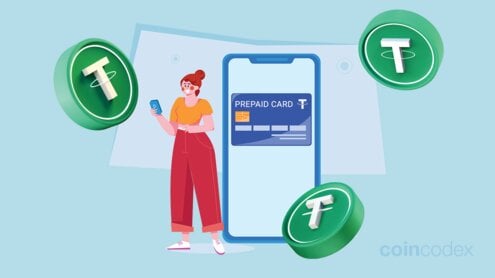Tether (USDT) prepaid cards are a convenient and secure way to spend your USDT. They are accepted by merchants that accept Visa or Mastercard, and you can also use them to withdraw cash from ATMs.In this article, we are going to examine the 5 best Tether prepaid cards available in the market today and compare their fees, features, and more.A Tether prepaid card can be loaded with Tether (USDT), a stablecoin pegged to the US dollar. Thus, 1 USDT is always worth approximately 1 USD.USDT prepaid cards can be used to make purchases at merchants that accept Visa or Mastercard or to withdraw cash from ATMs. They are a convenient way to use Tether in the real world without having to convert it to fiat currency first.To obtain a USDT prepaid card, you will typically need to create an account with a cryptocurrency company and go through a KYC (know your customer) process. Once your account is verified, you will be able to use the card. It is worth noting that some platforms allow you to use USDT from your account directly, while others require USDT to be transferred to a separate wallet, reserving it for card payments exclusively. There is a significant overlap between the best USDT prepaid cards and the best crypto credit and debit cards in general. In the following sections, we’ll examine the top prepaid cards for USDT holders available in the market today.The Crypto.com Visa Card is another prepaid Visa card that allows you to spend your Tether and other cryptocurrencies directly. The card is accepted wherever Visa is accepted. Crypto.com’s crypto card allows users to earn up to 5% on their purchases. Keep in mind that the exact cashback amount depends on card tiers, which are determined by the amount of CRO that you have locked up.Key features: Get a Crypto.com Visa CardThe Trustee Card is a payments card provided by Trustee Plus, a crypto wallet that allows users to spend their cryptocurrency balances in everyday situations. The card has a €5,000 daily spending limit and a €50,000 monthly spending limit. Thanks to an integration with Binance Pay, you can top up your Trustee Plus account with USDT tokens you hold on Binance with zero commission; but you’ll have to first open a Binance account for that. To learn more about Binance’s partnership with Trustee, check the official post.Key features: Get a Trustee CardThe Wirex Card is a prepaid Visa card that can be used to pay with cryptocurrencies and fiat currencies directly. Wirex’s card is accepted by merchants worldwide and can be used to withdraw cash from ATMs. Wirex rewards users with up to 8% cashback, the company’s special promotion called ‘Cryptoback’.Key features: Get a Wirex CardThe Nexo Card is a dual-mode crypto credit and debit card that allows you to spend your crypto assets without having to sell them. It is issued by Mastercard and is currently available in Europe, with plans to expand to other regions soon. In credit mode, the Nexo Card functions as a credit card linked to your Nexo Credit Line. In debit mode, the Nexo Card functions as a debit card linked to your Nexo account. When you make a purchase with USDT, for instance, the amount is automatically deducted from your Nexo account balance.Key features: Get a Nexo CardBybit Card is a prepaid Mastercard crypto debit card offered by the Bybit crypto exchange that allows you to access and spend your USDT and other cryptocurrencies in an effortless manner, bridging the gap between digital assets and everyday transactions.Key features: Get a Bybit CardTechnically speaking, the main difference between prepaid and debit cards is that prepaid cards are not linked to a bank account, while debit cards are. This means that when you use a prepaid card, you are spending money that you have already loaded onto the card. When you use a debit card, you are spending money directly from your checking account.However, when it comes to crypto, “debit card” and “prepaid card” terms are typically used interchangeably. Crypto cards cannot access money from your checking account directly, which means that they need to be topped up with crypto or fiat before you can use them – hence the prepaid classification. On the other hand, crypto cards are connected to your exchange account and can use the funds deposited in the exchange account directly, hence the debit classification.Yes, most crypto cards that support USDT are debit cards.USDT prepaid cards are a great way to put your crypto funds to use for daily purchases and to pay for expenses. However, they are just one aspect of how the crypto and traditional finance industries have joined forces in recent years. For example, you can buy Bitcoin with Apple Pay at numerous crypto exchanges, use gift cards to buy Bitcoin and other cryptocurrencies, and even use your Amex card to invest in Bitcoin.

